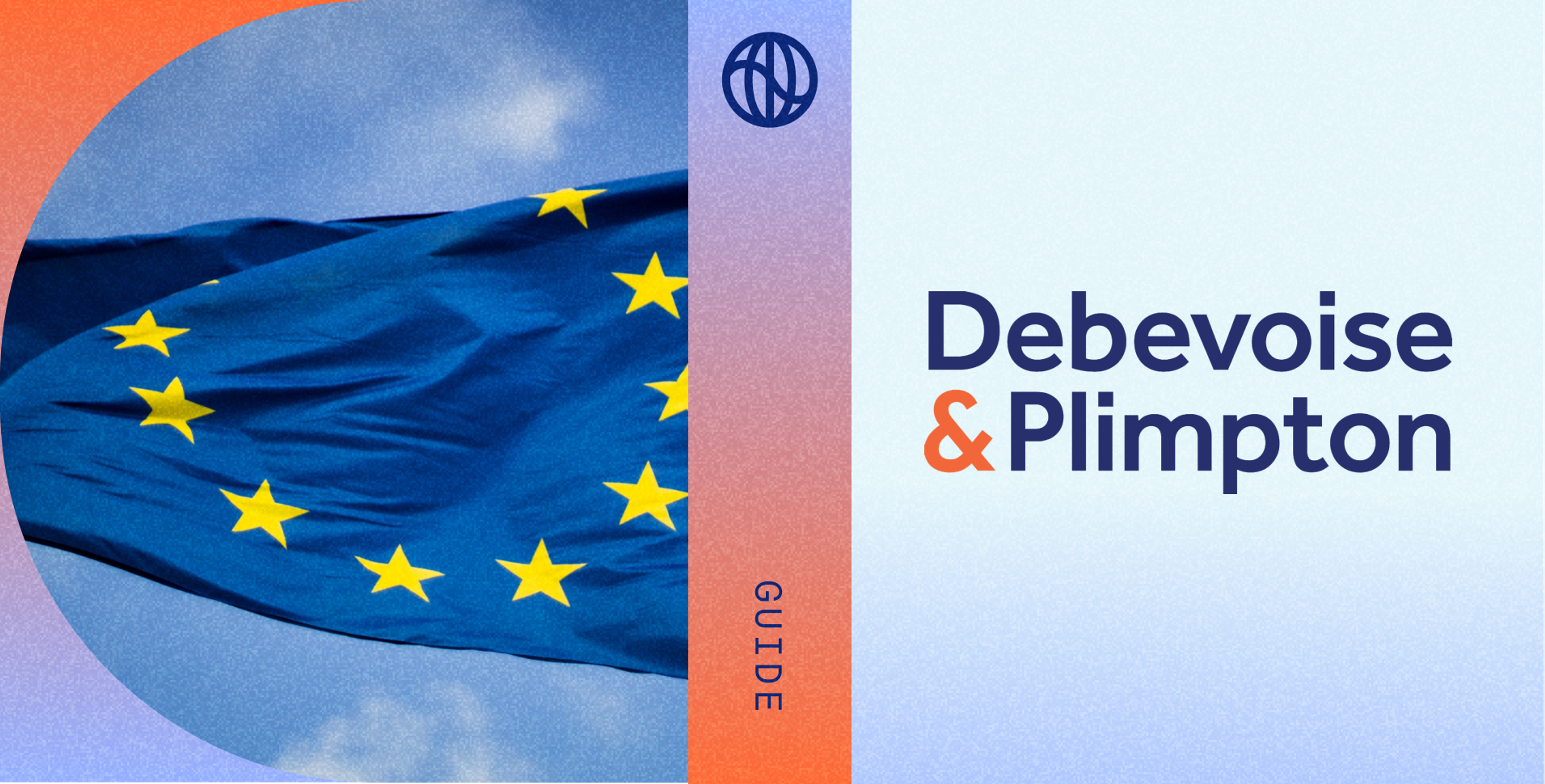


As part of a push for robust environmental action, the EU has replaced their legacy environmental, social, and governance (ESG) reporting programme, the Non-Financial Reporting Disclosure (NFRD), with the Corporate Sustainability Reporting Directive (CSRD).
The CSRD is intended to bring sustainability reporting up to the same quality and control bar as financial reporting; companies will need to bring a new level of rigour to their ESG reporting as they comply with the regulation.
Watershed sat down with members of the European ESG team from Debevoise & Plimpton to hear more about how companies should prepare for the legal requirements of the CSRD.
Patricia Volhard is a partner in Debevoise’s Frankfurt, Paris and London offices and is a member of the firm’s core group of ESG partners. Her practice focuses on advising private funds and corporates, including on the full range of European regulatory issues, such as SFDR, CSRD, and other ESG related regulation.
John Young is a London-based international counsel and member of the firm’s Funds/Investment Management Group. He advises asset and investment managers on a wide range of regulatory issues impacting the sector, including the EU’s framework for ESG considerations in investment management.
Alfred Scott is a London-based trainee solicitor in the firm’s Funds/Investment Management Group, with a particular interest in ESG related regulation and impact investing.
How should companies generally prepare for the CSRD?
Debevoise: In contrast to its predecessor, the NFRD, CSRD applies to more EU companies and introduces a consistent and detailed set of reporting standards. This is combined with external “assurance” to make non-financial reporting comparable to traditional financial reporting.
Companies in scope should prepare to report extensive information on sustainability matters in their annual reports, which will be uploaded to a publicly searchable database (known as the European Single Access Point).
This will include information on business model, strategy and policies (such as due diligence processes), sustainability risks and opportunities, climate transition plans. It also covers the role of management bodies in sustainability matters, information on sustainability matters in supply and distribution chains, and a material assessment both of the impact of ESG factors on the company, and the company’s impact on the wider environment and society.
Most companies will be reporting some level of sustainability information already, and will need to build on that to develop a governance and compliance framework to implement CSRD’s requirements.
How should companies prepare for the Climate Change standard?
As the European Sustainability Reporting Standards (ESRS) on Climate Change is substantially aligned to the Task Force on Climate-related Financial Disclosure recommendations, companies that report under this regime will have a large body of the information necessary to meet the ESRS climate reporting standard.
What do you expect to be the most difficult aspect of creating a CSRD-compliant annual report?
Debevoise: Companies will need a consistent and repeatable process for CSRD reporting, which will be supervised by their audit committee (or board) and subject to external assurance from their auditor or another service provider. They will need to identify and address gaps in their current reporting capabilities and in particular identify the most challenging data points (such as Scope 3 greenhouse gas emissions in their value chain).
Businesses will also need to put in place a process to determine what information is “material” under the CSRD principle of “double materiality reporting”, which requires companies to report on both sustainability risks and opportunities that may positively or negatively affect the entity’s financial performance and wider considerations of “impact materiality."
Crucially, companies will also need to consider the level at which information is presented, as CSRD reporting standards require information to be reported in relation to individual entities, sectors, countries, sites and operations (such as environmental impacts or workforces), if that information is considered material.
Finally, companies will also have to report on sustainability related factors in both their upstream and downstream value chains, where this is required under a particular Reporting Standard, such as information on workers at their world-wide suppliers.
Where will the CSRD reporting go in a company’s financial report?
Debevoise: Companies must include CSRD reporting as a “dedicated section” of their annual management reports under the relevant EU legislation (the Accounts Directive). Companies may publish their annual financial statement and management report as separate documents, and they need not be published on the same date (although they will refer to the same reporting period).
What are the liability implications of failing to comply or providing false information?
Debevoise: Though CSRD does not introduce any new liability provisions, company directors are responsible for the accuracy of the information in their annual reports under relevant national law, with additional liability for directors of listed companies.
What do we know about potential fines, penalties, or risks for CSRD disclosures?
Debevoise: EU member states will set their own penalties for infringement of the requirements (which are contained in amended versions of the EU Accounts Directive and EU Transparency Directive, which governs listed issuers). For companies which fall within scope of CSRD by having a listing on an EU regulated market (of shares, debt securities or depositary receipts), the Transparency Directive requires Member States to designate a competent authority as responsible for supervising their obligations.
This will include specific powers for those authorities to enforce the obligations, including requiring disclosure of information, suspending trading in a company’s securities and publicly “naming and shaming” the issuer if it is failing to comply with its obligations.
How should companies approach the audit assurance requirement?
Debevoise: Companies will need to appoint an auditor (or other independent assurance provider) to give an opinion, based on a “limited assurance” engagement, on whether the company’s sustainability reporting complies with the requirements of CSRD.
The checks performed under the limited assurance engagement are not yet particularly clear, but are likely to focus on the process used to compile the information, which would cover a company’s policies on sustainability reporting, sources of information, and process to select “material” topics for reporting (addressing, for instance, any bias in the reporting).
However, it is unclear how the auditor will perform assurance on quantitative information vs. qualitative (narrative) information and on forward looking information (such as the reasonableness of environmental targets). We will need to see the further “Level 2” rules and to look at how auditors’ practices develop to understand this more fully.
How are companies approaching understanding their obligations with regards to reporting at consolidated, global, or subsidiary levels? Will there be companies who can choose between options?
Debevoise: There are essentially two ways in which a company comes in scope of CSRD: either by being an EU entity which exceeds certain size thresholds—either on a stand-alone basis or by reference to its subsidiaries—or by the entity having a listing of equity, debt or depositary receipts on an EU regulated market and exceeding certain size thresholds.
For many world-wide groups, this will mean that only part of the group is subject to CSRD (although the EU intends in certain cases where the EU revenue exceeds EUR 150 million for a form of CSRD reporting to apply on a consolidated group-wide level from 2028).
A key decision for groups which are in scope at the outset is whether—and when—to apply CSRD reporting on a group wide voluntary basis. Factors in this decision include alignment with the group’s existing voluntary sustainability reporting, the interests of its shareholders and other stakeholders, and the expected large overlap of CSRD with the forthcoming Corporate Sustainability Due Diligence Directive (CSDDD), which requires companies to perform due diligence and publish information on human rights and environmental impacts in their own operations and in their world-wide value chains. CSDDD will apply from 2025 at the earliest.
Note that, under the current draft of the CSDDD, companies that publish information under the CSRD are relieved from the obligation to publish an annual statement on the matters covered by the CSDDD.
Can companies with more than one EU subsidiary who will not report on a group-wide basis report on a consolidated basis across all EU operations? If so, how might they choose which EU subsidiary should be responsible for CSRD reporting?
Debevoise: Until January 6th, 2030, non-EU companies with more than one EU subsidiary in scope of CSRD can prepare a consolidated sustainability report that includes all EU in scope subsidiaries (although subsidiaries in scope of CSRD whose securities are admitted to trading on an EU regulated market will still have to produce their own reports). This is designed to help companies who may find filing reports for each individual subsidiary particularly complex, especially if these EU subsidiaries do not sit in a single consolidated group.
The EU subsidiary that prepares the report should be one of the subsidiaries that generated the greatest turnover in the EU in at least one of the preceding five financial years, on a consolidated basis where relevant.
